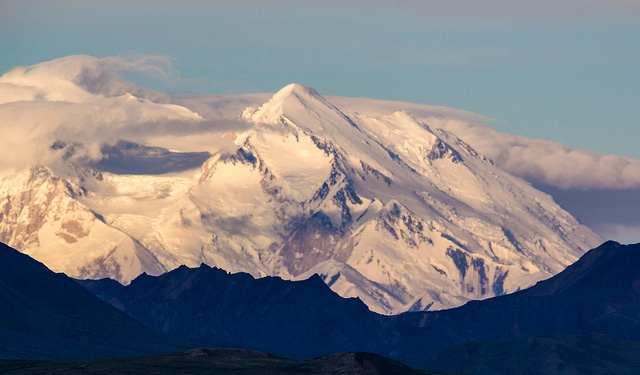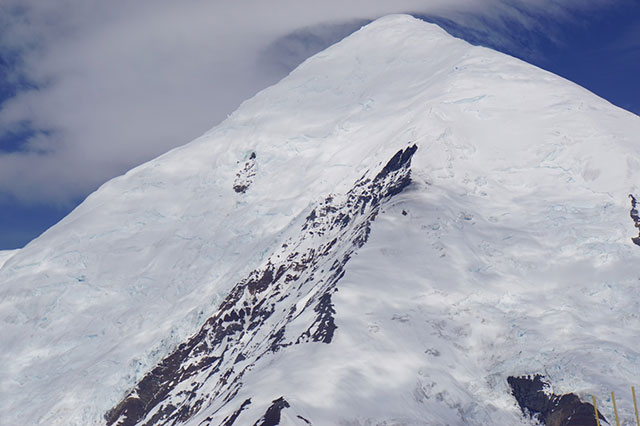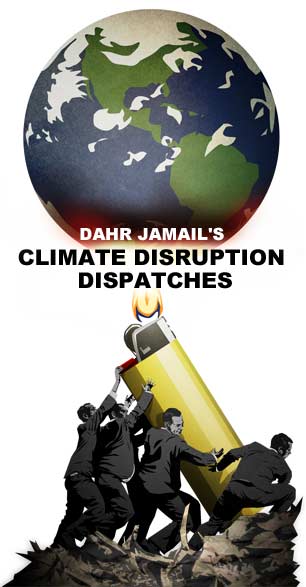
Part of the Series
Climate Disruption Dispatches
Planet or Profit
Honest, paywall-free news is rare. Please support our boldly independent journalism with a donation of any size.
I recently visited Denali, the highest mountain peak in North America and my favorite place on the planet, for the first time in 13 years. Prior to working full time as a war reporter, I lived in Alaska for nearly a decade, where my life revolved around spending my summers mountaineering in the Alaska Range.
Denali in particular has always been close to my heart. As an alpinist, I take my orders from the mountains and see them as living things. So I make my climbing plans, but then, of course, they are always subject to the weather and route changes the mountain dictates at any given time.
To see more stories like this, visit “Planet or Profit?”
Having worked on Denali as both a guide and a volunteer rescue ranger with the National Park Service, I’ve been lucky enough to have stood atop Denali several times, and the influence the mountain has had and continues to have on my life has been profound.
By viewing the mountain as a living thing, I also now view it as a being that is suffering from the impacts of anthropogenic climate disruption (ACD). The signs this year, along with anecdotal evidence from my mountaineering ranger friends, are overwhelming.
There have been mosquitos at basecamp at 7,200 feet on the Kahiltna Glacier for the last two years — something that had never happened before. We had instructions to wear helmets at two areas of the route where falling rocks have now become common. One of those sections is located between 17,200 and 18,200 feet, which means rocks and boulders that have been frozen solid in ice for thousands of years are now melting out and falling onto the climbing route not far from the summit of North America’s highest mountain. The lower glacier has melted down more than 50 feet in just a decade in some areas, according to one of the rangers I worked with.
Another long-time Denali mountaineering ranger told me of a phenomenon on Mt. Crosson, a mountain nearby Denali, where rock and soil that are becoming increasingly exposed by melting glacier are blowing onto the ice — which is accelerating the melting, as the rock and soil warm and melt more ice.
 Mt Crosson, located near Denali, is experiencing increasing melting as exposed rock and soil are blown atop ice. (Photo: Dahr Jamail)
Mt Crosson, located near Denali, is experiencing increasing melting as exposed rock and soil are blown atop ice. (Photo: Dahr Jamail)
Given all of these extreme shifts, climbing is becoming exceedingly dangerous and unpredictable as the years go by.
Seeing these changes firsthand on Denali, a mountain 20,310 feet high and quite close to the Arctic Circle, it comes as no surprise that equally dramatic changes are happening in the Antarctic, as well as other places around the planet.
Antarctica’s Totten Glacier is now unstable and will likely be contributing significantly to multi-meter sea level increase by 2100, if mid- to worst-case climate disruption scenarios play out, according to a recent study.
 It is no mystery where all of this melting is coming from: Global carbon dioxide content in the atmosphere is now consistently over 400 ppm, which means we are literally rewriting the history of the planet. The last time there was this much carbon dioxide in the atmosphere, it was between 15 and 20 million years ago, at which point temperatures were between 3 and 6 degrees Celsius warmer than they are now, and global ice sheets had melted to a point where sea levels were between 25 and 40 meters higher than they are now (the Greenland Ice Sheet did not exist), according to a 2009 study in the journal Science.
It is no mystery where all of this melting is coming from: Global carbon dioxide content in the atmosphere is now consistently over 400 ppm, which means we are literally rewriting the history of the planet. The last time there was this much carbon dioxide in the atmosphere, it was between 15 and 20 million years ago, at which point temperatures were between 3 and 6 degrees Celsius warmer than they are now, and global ice sheets had melted to a point where sea levels were between 25 and 40 meters higher than they are now (the Greenland Ice Sheet did not exist), according to a 2009 study in the journal Science.
To put that another way, we are locking in between 120-190 feet of sea-level rise, and the Intergovernmental Panel on Climate Change’s worst case predictions for temperature rise, over the long term.
As dramatic as the current changes are, they pale in comparison to what studies warn is coming our way.
One recent study stated that even mid-range predictions of climate scenarios (bearing in mind we’ve seen even worst-case scenarios being consistently surpassed) will likely force human and animal populations living near the equator to migrate to cooler temperatures.
In the direst prediction yet, a study published recently in Nature Climate Change provided us with a view of the world if we continue burning fossil fuels unabated. If that occurs, and to date there is nothing to indicate that it will not, the planet will be 8 degrees Celsius warmer than pre-industrial baseline temperatures, and Earth will have the climate it did 52 million years ago. This means there will be crocodiles and palm trees in the Arctic, where temperatures will increase by 17 degrees.
The study predicted that if significant changes in emissions do not occur, by 2300, greenhouse gases will literally transform the planet into a place where food is scarce and large areas of the world will be uninhabitable by humans. Vast numbers of species of plants and animals would be annihilated.
Myles Allen, the head of a climate dynamics group at the University of Oxford in the United Kingdom, focuses his research on carbon’s cumulative impacts on climate. Allen told National Geographic that it took less warming — about 6 degrees Celsius — to lift the world out of the Ice Age than the planet may be facing over the next 200 years. Allen said, “That’s the profundity of the change we’re talking about.”
The Earth would resemble what it looked like during the Eocene period 52 to 56 million years ago, when horses shrank to the size of house cats as their evolution adjusted to a diet changed by heat and/or carbon. Melting of all the ice at the poles would cause sea-level increases that would displace the 40 percent of the global population that lives near a coast, precipitation in the tropical Pacific would quadruple, and in the Americas, precipitation would be reduced by one third.
Tropical rainforest systems around the world would collapse. In southern Europe and the US, Allen told National Geographic, drought would be “completely catastrophic for agriculture.”
This picture may appear, at first, like science fiction. However, disconcertingly, signs of several of these dire predictions are already evident, as we survey the planet in this month’s dispatch.
Earth
Crops around the world are now becoming increasingly toxic in order to withstand ACD-influenced extreme weather conditions. When their life-sustaining water becomes ever more scarce, plants find a way of surviving the extreme condition. But that means that, by adapting to their increasingly harsh environments, they accumulate toxins at levels dangerous enough to kill livestock and cause cancer and other serious illnesses in humans.
Southern African countries have been coping with their worst food crisis in a quarter of a century as food prices and rates of malnutrition are both soaring. In Angola, 1.4 million people are suffering from drought and malnutrition rates have doubled; at least 95,000 children are being impacted. A “red alert” has been issued for much of Mozambique, where most of the year’s harvest was lost, and nearly half a million people have been given food aid. In Malawi, 8 million people (half the country), needs food aid (one million tons of food) for the second straight year.
Meanwhile, ACD is threatening the physical existence of world-renowned tourist areas like Easter Island and Stonehenge, as extreme weather events bringing coastal erosion are affecting the sites.
Yet more evidence of how ACD is literally changing the landscape of the planet comes from NASA, which recently released a study showing that large swaths of Canada and Alaska are becoming greener as a result of ACD.
Water
A recently published scientific report in the journal Marine Biology showed that ACD-driven ocean acidification, which occurs when carbon dioxide is dissolved in ocean waters, is both killing and stunting the growth of young crabs, which has the potential of placing entire crab populations at risk of annihilation.
A massive coral bleaching event that impacted the entire Great Barrier Reef in Australia has left roughly one quarter of the coral dead, and scientists now believe that it could well be too late to save what is left, given the ongoing warming of the oceans, coupled with worsening pollution from Australia.
That event, as broad in scope as it was, is merely a snapshot of a far larger global coral-bleaching event that is ongoing as the planet’s oceans are being heated to levels never seen before. Scientists around the world are now wondering what, if anything, can be done to keep coral reefs from disintegrating into the sea.
Meanwhile, rising seas are posing new sets of problems on a regular basis.
In the Florida Everglades, seawater is beginning to make its way into swamplands. As it continues, this development will irreversibly change the Everglades — and life for millions of people living in South Florida who depend on a freshwater aquifer underneath them, which is now at risk.
Drinking water issues are set to become increasingly problematic for those in the Western US as well, but for entirely different ACD-driven reasons.
The entire Western snowpack of the Rockies, Sierra Nevada, and Cascade mountain ranges, upon which tens of millions of people rely for water, is shrinking, due to the snow level making its way higher and higher into the mountains as temperatures continue to warm. Along with water shortages, this will cause forests and grasslands in the lower elevations to dry out, which will increase the number, size and strength of future wildfires.
California’s snowpack in the Sierra Nevada is already at a 500-year low, and Lake Mead, the largest reservoir in that state, is already at an all-time low, a phenomenon which may well leave the seven states that depend on it for drinking water in a very bad position.
It’s not just the western US that is experiencing a dramatic quickening of the melting of its snow. The northernmost community in the US, Barrow, Alaska, posted its earliest spring snowmelt on record, according to federal scientists. Overall this year so far, Alaska’s average temperature is the highest on record, at 11.4 degrees Fahrenheit above the average temperature between the year 1025 and the year 2000.
By May, the Arctic sea ice had shrunk to its fourth-lowest level in half a century, according to the National Snow and Ice Data Center in Boulder, Colorado. This summer could well see the lowest sea-ice extent in recorded history.
Meanwhile, permafrost across Alaska’s north slope is continuing to warm at a pace that is now 70 years ahead of the pace predicted just a few years ago, according to recent research.
A stunning recent report revealed that 95 percent of all the glaciers atop the massive Tibetan plateau have receded, and are continuing to do so at rates never seen before.
As the atmosphere warms, it is able to hold increasing amounts of moisture, so intensifying downpours continue to be the norm. This was evidenced recently in West Virginia, where downpours in June left 26 people dead while setting records for the worst flooding in the state for more than a century.
Fire
It should come as little surprise that as planetary temperatures continue to increase at a record-breaking pace, wildfires are increasing right along with them.
Recent data shows that, since the 1980s, wildfires across the western US have been occurring with greater frequency, are far larger and are burning longer. Increases in all three areas of measurement have been happening every decade, and are continuing.
Already across the southwestern US, wildfires across five states are burning largely out of control due to a record-breaking heat wave and extremely dry conditions, forcing the hardest firefighting work to be carried out during the night.
In drought-stricken California, one of several wildfires has consumed more than 80 buildings and forced hundreds of people to evacuate their homes. Fires in the state are threatening at least another 1,500 buildings, and one of the firefighters has described it as “a firefight of epic proportions.”
In Arizona, at least four people died and a staggering 30 million more were under heat advisory as temperatures reached 120 in some areas and wildfires raged across the region.
In a truly apocalyptic scene from May, fire fighters in Canada faced 1,100 degree flames while battling fires near the country’s oil sands.
Also in late May, wildfires across Russia had already burned an area the size of Vermont and Delaware combined, as the country announced it expected its worst wildfire season in over a century.
Air
In early June Greenland was hotter than New York City, in a prescient sign of the times.
Predictably, May was the warmest May on record for the planet, according to NASA. It beat the previous record, which was May 2014, by a long shot, and marked the 8th straight warmest month on record in NASA’s database. June is likely to follow suit.
Researchers recently revealed, in detail, how extreme weather-related disasters around the world are getting worse and costing more, largely due to the impacts of ACD. In the US alone in 2015, 10 extreme weather events cost more than $1 billion apiece and killed 155 people. Between 1980 and 2014, nearly 1 million people around the world were killed in tropical storms, floods, droughts, heat waves and other extreme weather events.
Denial and Reality
In yet another stunning example of ACD-denialism, the Republican Party is actively working to attempt to stop the Pentagon’s climate plan.
Ever since George W. Bush was president, the US Department of Defense has been warning that ACD posed a major threat to the national security of the US, and stating that preparation must begin promptly. Recently, however, House Republicans voted to block the Pentagon’s ACD preparation plan, then went on to pass an amendment that prohibited the defense department from spending money to put its preparation plans into effect. This was the second time the House GOP has actively voted to halt the Pentagon’s ACD policies.
On the living-in-reality front, the city of Portland, Oregon recently voted to ban all ACD-denying textbooks from all of its schools.
Recent reports from British and US research stations in the Antarctic showed that carbon dioxide levels on the ice continent exceeded 400 ppm for the first time in 4 million years. Researchers there reported that greenhouse gas emissions have “changed our planet to the very poles.”
Lastly for this month’s dispatch, a study recently published in the Proceedings of the National Academy of Sciences showed that there is essentially no landscape left anywhere on Earth that has not already been altered by humans. This means that the end of true nature has essentially been confirmed by scientists.
“‘Pristine’ landscapes simply do not exist and, in most cases, have not existed for millennia,” wrote the authors of the study.
Press freedom is under attack
As Trump cracks down on political speech, independent media is increasingly necessary.
Truthout produces reporting you won’t see in the mainstream: journalism from the frontlines of global conflict, interviews with grassroots movement leaders, high-quality legal analysis and more.
Our work is possible thanks to reader support. Help Truthout catalyze change and social justice — make a tax-deductible monthly or one-time donation today.